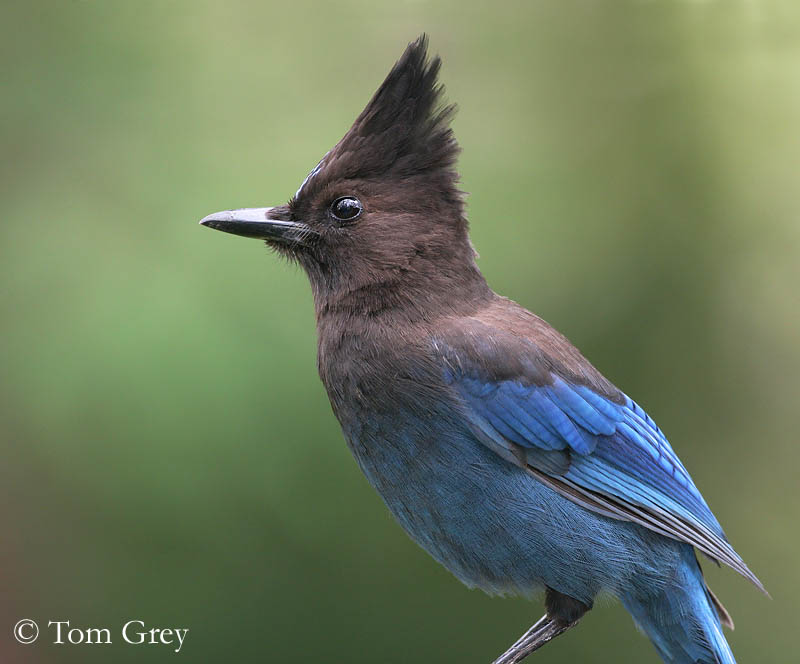
Steller’s Jay
Cyanocitta stelleri
Passeriforme Order - Corvidae family
BIOMETRICS:
Length: 30-34 cm; Wingspan: 43 cm; Weight: 100-140 g
LONGEVITY: up to 16 years
DESCRIPTION:
Steller’s jay has black erected crest on head top. It has some bluish streaks on forehead and chin. Head, back and upper breast are blackish. Upperparts are dark blue, including wings and tail.
Underparts are greenish blue on lower breast and belly, and brighter blue on vent and undertail coverts. Under wings are grey.

Birds (Cyanocitta stelleri macrolopha) from Central and southern Rockies, have long crest, paler back, white streaks on forehead and chin, and white crescent around eyes. Wings show narrow black barring. Rump and tail present black barring, overall towards the tip of the tail.
Bill is black and pointed. Eyes, legs and feet are black too.
Both sexes are similar, with female slightly smaller than male.
Juvenile resembles adult, but head and body are greyish black.
VOICE: SOUNDS BY XENO-CANTO
Steller’s Jay’s calls include series of raucous “shack” or “shooka” notes. It has a large variety of loud and harsh calls, some mimicry (screams of hawks), harsh “shaar” and rapid “shek-shek-shek”.
Song is a soft warbler.
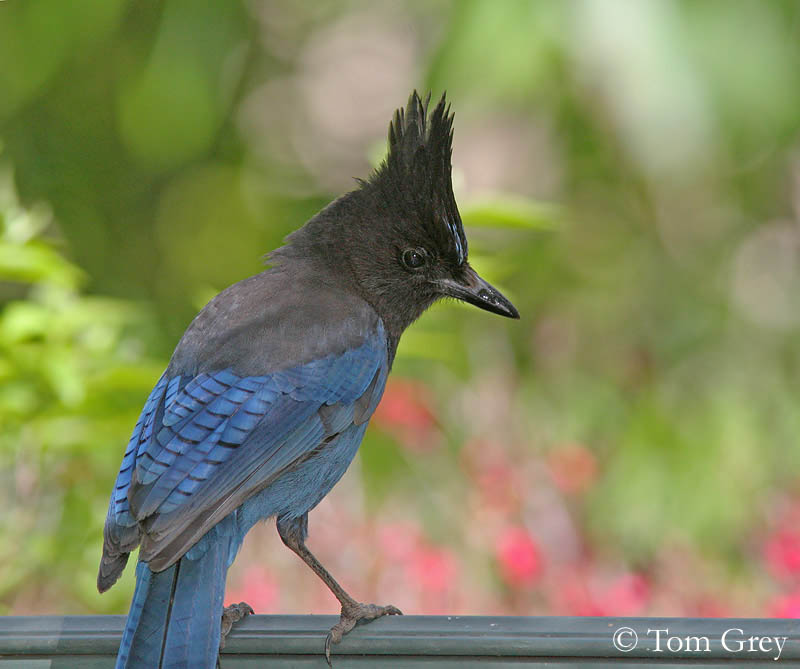
HABITAT:
Steller’s Jay is common in pine-oak woodlands and coniferous forests. It needs open woodlands, and we can find it in gardens and orchards.
RANGE:
Steller’s Jay is resident from southern coast of Alaska, southward through Rocky Mountains into Mexico, through Central America to north-central Nicaragua.
Western edge is along Pacific coast and eastward to eastern Colorado.
BEHAVIOUR:
Steller’s Jay is resident in most part of its range, but birds living at high elevations may move to lower altitudes during winter.
Steller’s Jay is shy and wary, and feeds mostly in tree tops, but it becomes accustomed to human in picnic areas. They beg boldly for food, with raspy calls.
Steller’s Jay takes advantage of news food sources, and it hides nuts for later.
It may open hard nuts with its bill, pecking them while holding with feet. It forages mainly in trees, but also on the ground.
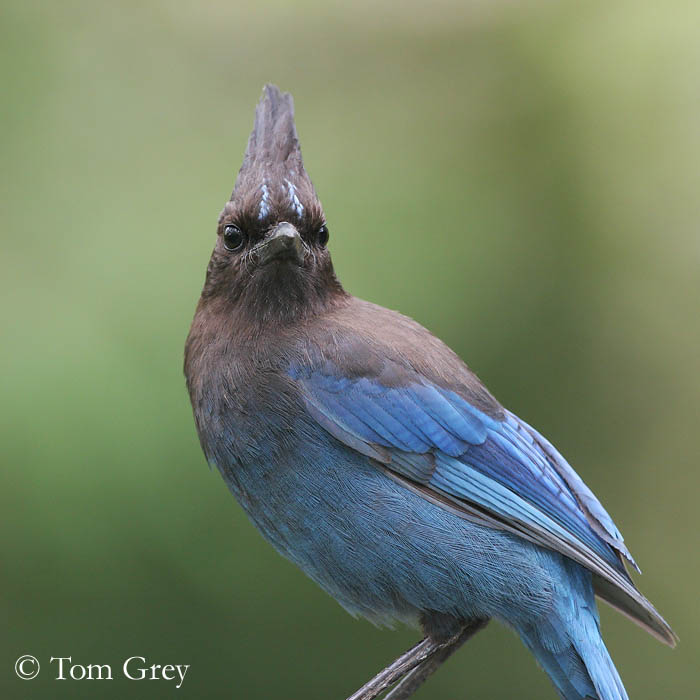
During the courtship, male feeds female. They are monogamous, and perform some displays. They form long-term pair bonds. Both adults select nest site and build the nest.
Steller’s Jay is gregarious. They have several forms of aggressive behaviour among their different flocks, including fighting while flying (the two birds attempt to grasp and peck each other with the bill), crest display, wings spread to express submission, and gathering in large noisy numbers to harass predators.
FLIGHT:
Steller’s Jays gather in flocks outside breeding season, and often, this flock flies across clearings in single file.
REPRODUCTION:
Steller’s Jay’s nest is built by both adults, high in trees (3 to 12 metres) or shrubs, and sometimes in tree hollows or buildings.
Nest is cup-shaped, and made with thick plant fibres, twigs and rootlets, held with mud, and lined with needles, rootlets and fine materials, and often with some bits of paper to adorn outside.
Female lays one egg per day, and the clutch includes 2 to 6 blue or pale green eggs, spotted with brown. Incubation lasts about 16 to 18 days, mainly by female fed by the male during this period. Young hatch altricial, and fledge about 18 days later. Parents feed them for about one month more. They remain with parents during first winter.
This species produces one single clutch per year, and is solitary nester.
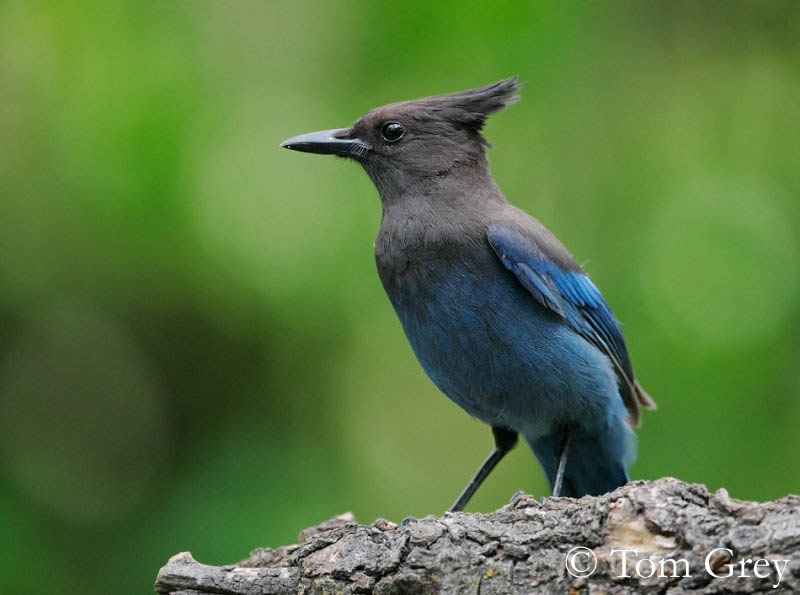
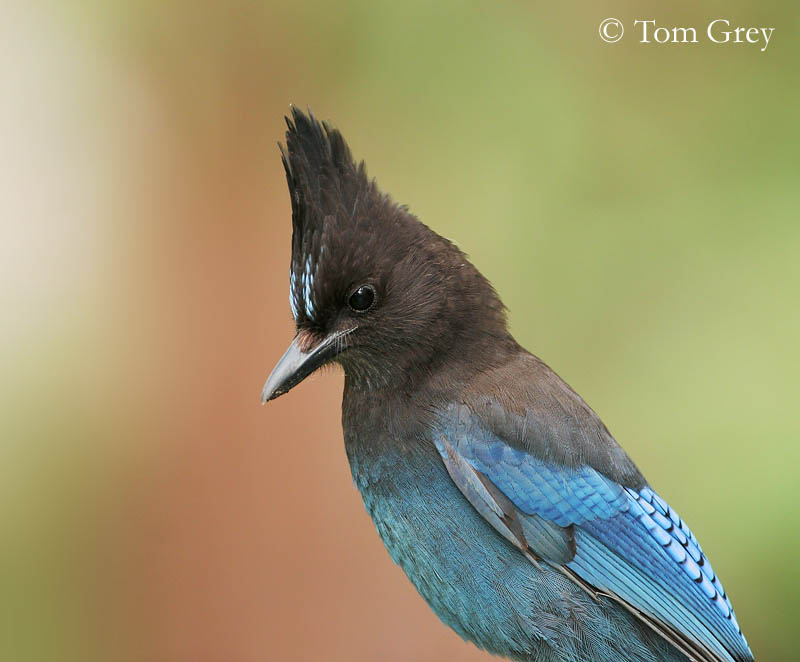
DIET:
Steller’s Jay is omnivorous. It feeds mainly on nuts, pine seeds and acorns. But it also consumes eggs of other birds, and it scavenges in developed human areas.
During the winter, Steller’s Jay eats seeds and nuts, berries and fruits, and may prey upon small invertebrates, small rodents, reptiles, and eats carrion and suet.
PROTECTION / THREATS / STATUS:
Steller’s Jay has typical predators, such as Cooper’s Hawks.
This species is not endangered.
Steller’s Jay is named after George Wilhelm Steller, German naturalist.
Fr: Geai de Steller
All : Diademhäher
Esp : Urraca Ocotera
Ital : Ghiandaia di Steller
Sd : Stellerskrika
Photographs by Tom Grey
His website: Tom Grey's Bird Pictures
Text by Nicole Bouglouan
Sources:
FIELD GUIDE TO THE BIRDS OF NORTH AMERICA - National Geographic Society - ISBN: 0792274512
BIRDS OF THE GREAT BASIN – by Fred A. Ryser - Univ of Nevada Pr -ISBN: 0874170796
A GUIDE TO THE BIRDS OF MEXICO AND NORTHERN CENTRAL AMERICA by Steve N. G. Howell, Sophie Webb - Oxford University Press - ISBN: 0198540124
All About Birds (Cornell Lab of Ornithology)
Bird Web (Seattle Audubon Society)
Wikipedia (Wikipedia, The Free Encyclopedia)
What Bird-The ultimate Bird Guide (Mitchell Waite)